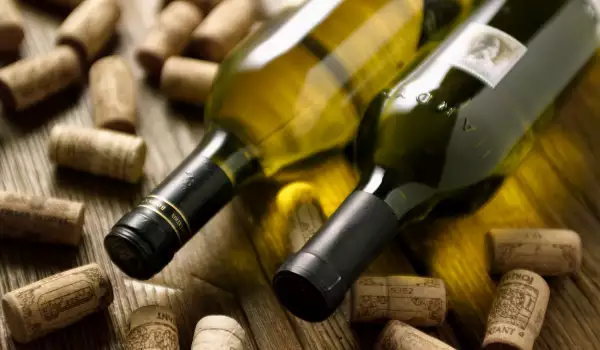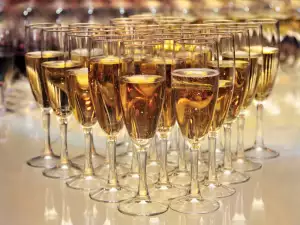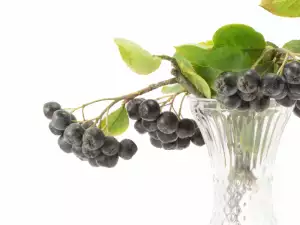"A bottle of wine contains more philosophy than all the books in the world."
The thought of Louis Pasteur leads us to ask whether it is possible for a person to fully understand and know the nature of this divine drink with every sip makes us find ever new horizons - all as different and unique as each individual is unique bottle of wine. Because wine has a soul, its initially young life reaches its peak and then acquires the characteristics of aging.
Wine is a type of alcoholic beverage obtained by the fermentation of grapes, although wine can be prepared from other fruits, flowers, and wheat. The very word "wine" comes from the Greek word "Fοινος", which translates as wine and vine.
The challenge for any self-respecting wine producer is to get that unique drink, the combination of a bouquet of flavors to leave tasters without words. In the science of wine they have even invented special terminology that relates to dominant colors, finish and other characteristics of the wine.

There is something that exhausts the whole philosophy of a bottle of wine and at the same time it’s so vague and difficult to formulate even for prominent wine professionals. It's about the terroir of the wine - this complex collaboration of subjective climate conditions of the area, soil slope, method of viewing the vineyard, the grape variety, time of harvest of vineyards, methods of storage, etc. Terroir is the driving force of the European concept of quality wines and the term is trying to unite ourselves with each subject in the life of grapes, manufacture and aging.
The very life of wine is inextricably linked to life on earth, and in particular that of humans. Is the first man-made drink is still debatable, but surely wine from time immemorial is one of the most popular and consumed beverages in the world, immediately after tea, coffee and beer. Even in biblical times, we can detect linkage of wine with religion and vice versa.
The complex nature of wine has inspired thousands of people through the centuries - poets, painters, writers, artists in all aspects, which in turn respond with thanks to this elixir of the gods, chanting it forever in their creations - poems, pictures, etc. The uniqueness of the wine causes it to be subject of a science - oenology and the cause of a separate profession - sommelier.
To get rid of the lyrical tone that started to tell you about the essence of wine to try in a summary to let you know the whole "wine world" - from the birth of the grape elixir and its history in the process and manufacturing technology and storage in content wine serving etiquette, coupled with food and ultimately the main characteristics of the different types of wines. We called it abstract because tomes can be written, and its story is still being written even today.
Making Wine
The process of making wine is long and specific to each region or vineyard, at which the drink is made. In this sense, conditions and traditions in winemaking are important. In general, wine is made from grape juice which is called wort. This must be obtained by squeezing the grapes in presses. As a result, this leads to grape juice (must) and marc (residual solid portion of the grapes).
Today, in many countries, production and consumption of wine is transformed into a religion that has ancient roots. One of the best and high quality wines produced in France, South Island of New Zealand (the southernmost point of the Earth's wine), Italy, Spain, Australia, Argentina, the U.S., China, Germany, South Africa, Chile, Portugal, Greece, Romania, Hungary and Bulgaria.
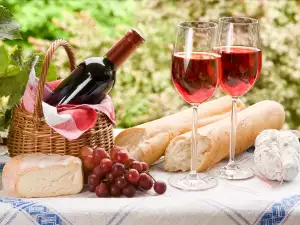
Types of wine
- White wine - it is made from both white and red or pink grapes. Time for fermentation after removing the grape skins is required. Right now - the removal of the skins, which contain colorants, defines this white grape drink. Among the most famous and widespread white varieties are Chardonnay, Sauvignon Blanc, Traminer, Semillon, Riesling, Pinot Gris, Muscat, Muscat and others.
- Red wine - with thousands of red grapes, red wine often takes the pedestal of "wine." Often when I mention wine, it is red. Fans of this grape drink are so fiercely set that in some cases they do not recognize other than red wine. As a rule, red wine is produced from red grapes whose coloring goes into musts. Unlike whites, red wines are fermented with solids (skins), allowing the flow of processes to extract pigments, tannins and other characteristic substances. The most famous red wines are Cabernet Sauvignon, Cabernet Franc, Mavrud, Merlot, Pamid, Rubin, Syrah, and more Gamza many. others.
- Rose Wine - Rose - Rose combines the colors of white and red wine, resulting in his shade that revolves around the rose - a pale and gentle to intense, is close to deep red color. Rose is made from red grapes, but use the technology for white wines. It is less tannic wine and has a taste close to white wine, but in terms of density and color, it is red wine. A darker color Rose is one that has undergone more intense pressing and longer fermentation.
There is also the so-called orange wines, which come from white wine grapes that have been stored for some time in contact with the grape skins. They are called orange because the color is dark and thick white and has a slight orange tint ranging from color "salmon" to dark amber. The technique for orange wine is opposite to that for making white wine. Traditions in orange come from Georgia and most suitable variety for this type of wine is the variety Pinot Gris.

Classification of wines
Besides red, white, rose and orange wine, wine is subject to complex and classification depending on different components.
According to the ratios of sugar and alcohol in different types of wine, they are divided into dry wine, dry wine, semisweet wines and dessert wines. As production technology distinguishes two other groups of special wines. This is sparkling wine (champagne from the Champagne region, natural sparkling wines, sparkling wine) and fortified wines (Madeira, Malaga, Porto, Sherry, Vermouth).
Europe was a dictator in wine for centuries, so there is the so-called European classification that divides the wines into table wines (available widely in terms of their price) and Quality wines (expensive and selected types). It is good to follow the French classification of wines that shares a table wine, local quality wines, wines made from varieties of quality in a relatively small region and the wines of controlled origin. These are wines of high quality local and foreign varieties produced in approved areas for the purpose of specific agro-meteorological conditions that give it a very specific flavor.
History of Wine
The history of wine is millennial and dynamic. There is evidence that even the Egyptian pharaohs consumed wine. The drink of the gods was an integral part of everyday Phoenicians around 1100 BC, when they were in their heyday. From this period are preserved distinct images of wine on many paintings, papyri and gravestones.
The wine tradition continues in Hellas, where the grape elixir is everywhere. This is where the wine is referred to as the drink of the gods, which has been the inspiration for many Greek artists. Greeks loved to mix wine with herbs, spices and honey and finally diluted with seawater. Omir describes wine with such epithets as "fragrant" and "sweetly fragrant".
2000 years later, the Byzantines made wine, which also had herbs and frankincense resins and smoked wax poured in amphorae. Aristotle describes an interesting method in which the wine is left to evaporate so long that it finally received a sticky, stringy texture. Centuries later, the wine coalesces with more everyday tradition and religion. It transformed into an industry where a science was conceived and a whole process of production, aging and tasting wines was develooped.

Composition of wine
A curious fact is that only one glass of wine contains about 600 ingredients. Tastes and aromatic qualities of each wine are due to the chemicals in it. These in turn depend on the grape variety, the wine region, soil type, sunlight, climate, amount of yeast, etc.
The composition of wine is approximately 80% water. After fermentation, from the grape sugar is produced ethanol - from 9 to 20 percent, which determines its durability.
Flavor characteristics of wines and their sourness depend on acids that are formed during the fermentation. An important component is residual sugar, which ranges from 1 to 200 g / l for different grape drinks. Thanks to sugars wine has a mild and pleasant flavor, but they themselves are not so big and the reason for its durability and kink storage.
Phenolic compounds in red wine determine its color and structure. They are usually from 1 to 5 g / l - anthocyanin (natural red pigments) and tannins. Wine contains a large number of aromatic substances that are volatile and are of different individual concentration. Furthermore, it includes amino acids, proteins and vitamins C, B1, B2, PP, B12.
Selecting and storing wine
If you are not familiar with wine, trust the advice of a sales consultant by requiring from him full information about a particular wine. Price is often leading in choosing a nice bottle, though its not always an absolute rule.
When you pour wine glasses, carefully look at them to see if there are any particles. Raise your glass on a white background if possible. Hold the cup straight, then bend slightly and concentrate on the color intensity of the wine hue, degree of transparency and brilliance, as well as the presence or absence of bubbles.
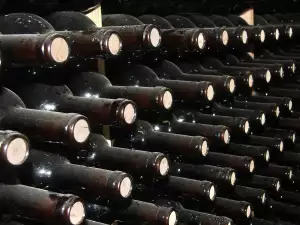
If the wine is pale, it means that it is smooth, but if bright and clear - it is highly acidic. You'll know that the drink’s acidity is softened if it is slightly matte. Ordinary young whites are white-green color and more mature ones are with a straw-gold color. Fully mature ones are amber. In red wines the principle is the same, only the color goes from purple to brown. Young wine is not good.
To store your best bottles of wine, keep them in a cool dark room with a temperature between 10-12 degrees. Bottles must stand horizontally, which ensures the cork does not dry out and the wine oxidizes from contact with air.
The humidity of the room should be between 65 and 80 percent. It is important for the storage of wine what type of concrete the floor is – if it is an all concrete floor, whether the shelf is wood or gravel or finely crushed stone and tile, which affects the wine better.
It is advisable to use a particular space only as a winery and nothing else, because the bottles are sensitive to different smells. Also an important point is that the room is a quiet place that has no danger of being shook by the passage of a train, tram or other vibrations.
Culinary uses of wine
Wine is deeply tied to good food. It can be used as an ingredient for a meal to enrich its flavor or be delivered to a particular specialty to harmonize the flavors of the food and to highlight them. Therefore, an important rule is to select the wine so that his power to combine the richness of the dish and flavor - the delicate flavor of the specialty.
The sharp and intense taste of food does not dominate the wine. Red wine is served at the heavier meats, white wine - to the meat of birds and fish, and Rose can be combined in different cases, game and fish. If you want to serve wine with dessert or some sweet morsels, best opt for champagne.
Popular and favorite of many of us is a combination of wine, aromatic cheeses and fruits. Hard cheeses such as Edamer are excellent with red wines rich in tannin. Goat cheese goes with dry white wines and red wines. Brie is also very well suited to red wine, but cheese soufflé must be served with white or rose wine.
Classic combination is Burgundy with game
It is difficult to track when people began to use wine in cooking, but it is certain that the Romans literally poured gallons in vats of food. In fact, in Roman cuisine, wines are the main focus. To this day, cooking with wine ensures excellent taste for almost all kinds of meats, various sauces and creams.
Label for serving wine
There are strict requirements for the label to serve and consume wines. Among the most basic rules is always to Serve well chilled wine, never warm because the cold can be warmed in the glass, but not well-chilled to allow maximum enjoyment of the bouquet and flavor. Dry white wine is served at a temperature of 8-10 degrees and strong white wines - about 10-12 degrees. Light red wines taste the best if the temperature is 14-16 degrees, and for strong red wines it should be 16-18 degrees.
Wine should not be kept in the refrigerator for more than 48 hours, and cooled down with a lot of ice or a freezer is a bad idea. It is called sharp tempering, or striking, in other words - speed cooling. In any case, it is not good for the wine. Fast cooling is survived only by white wine.
Never offer ice with wine at presentation to guests, although many people have this nasty habit in the consumption of wine, especially white. Supplements like lemons and other fruits are not recommended, unless you have cocktails with the addition of wine.
When pouring wine into glasses pour from the right side of the guest. Glasses are usually filled to 2/3 of their volume. Follow the law of the glasses, which are different for red, white wine and champagne. Serve red wine in decanters and white - right in the bottle because it is not decanted. If you intended to charm your guests with different types of wine, know that white wine is always served before red, young before old and light - before strong.
As for the label, with pouring champagne, it should never be poured into wet cups. Main focus of sparkling wine are the bubbles and foam that could be damaged by residual water in the glasses.

Benefits of Wine
Wine can bring benefits for our health and good spirits, but do not forget though, it is alcohol that intoxicates no less than other spirits. The charm of wine to some extent is in the quantity in which you consume it. Therefore, one cup a day is important for our body, but after the third cup, their action is no longer relevant because they themselves become free radicals.
Antioxidants in wine help us to keep the body young and toned. They fight and kill premature aging free radicals. It is believed that moderate amounts of wine helps the endocrine system in maintaining normal acidity of the stomach. This grape drink has antibacterial properties that help to draw toxins from the body.
Among other benefits of wine consumption are normal metabolism, improved sleep quality, good tone and restoring vitality and dilating blood vessels. Wine gives us many B vitamins and beneficial amino acids.
It has been shown that wine can protect against atherosclerosis and delay skin aging. It positively affects the levels of harmful cholesterol in the body and helps to deal with stress. Specifically - juice from grape seeds can prevent the formation of clots and has a positive effect on the cardiovascular system.
There is evidence that two glasses of white wine can help lower blood pressure and red in small doses is useful even for hypertensive patients. This divine drink dissolves sclerotic plaques in the blood vessels and reduces the risk of stroke.
